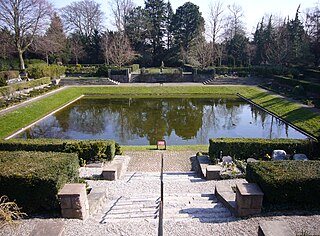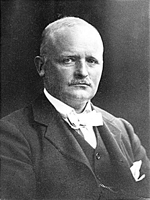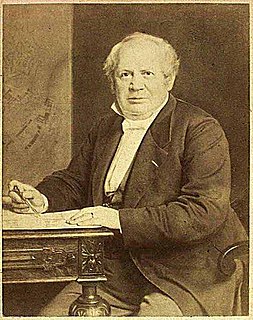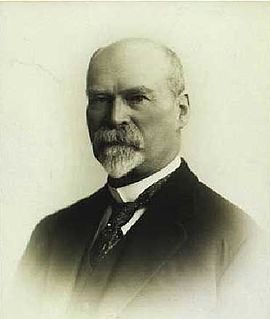
Vestre Cemetery is located in a large park setting in the Kongens Enghave district of Copenhagen, Denmark. With its 54 hectares it is the largest cemetery in Denmark.

Hack Kampmann was a Danish architect, Royal Inspector of Listed State Buildings in Jutland and professor at the architecture department of the Royal Danish Academy of Fine Arts. Marselisborg Palace in Aarhus, built between 1899 and 1902, is among his best known works.

The Royal Danish Academy of Music, or Royal Danish Conservatory of Music, in Copenhagen is the oldest professional institution of musical education in Denmark as well as the largest, with approximately 400 students. It was established in 1867 as Kjøbenhavns Musikkonservatorium by Niels Gade – who was also the first rector –, J.P.E. Hartmann and Holger Simon Paulli on the basis of a testamentary gift from the jeweler P.W. Moldenhauer, and with inspiration from the Leipzig Conservatory and a conservatory founded by Giuseppe Siboni in Copenhagen in 1827. Carl Nielsen was a teacher in the period 1916–1919 and the rector during the last year of his life.
Vedbæk is a wealthy suburban neighbourhood on the coast north of Copenhagen, Denmark. It belongs to Rudersdal Municipality and has merged with the town of Hørsholm to the north. The area has been inhabited for at least 7,000 years, as evidenced by the discovery of a Mesolithic cemetery of the Ertebølle culture. By the 16th century, there were a few small farms and fishermen's houses on the site and in the 18th century, well-to-do townsfolk from Copenhagen started to build country houses in the area. After a paddle steamer began to call at Vedbæk on its journey from Copenhagen to Helsingør, there was an influx of visitors. There are a number of large country houses and a historic church. There has been a railway station for some time and there are popular sandy beaches to the north and south. Enrum Forest is open to the public and provides recreational facilities.

Michael Gottlieb Birckner Bindesbøll was a Danish architect active during the Danish Golden Age in the first half of the 19th century. Most known for his design of Thorvaldsens Museum in Copenhagen, he was a key figure in the stylistic shift in Danish architecture from late classicism to Historicism. He was the father of the designer Thorvald Bindesbøll and the textile artist Johanne Bindesbøll.

Gammel Holtegaard is a former Manor house in Rudersdal Municipality north of Copenhagen, Denmark, today operated as an arts centre and a museum. It was built by the Danish Baroque architect Lauritz de Thurah (1706–1759), for his own use in 1757. Its original Baroque gardens were reconstructed in 2003.

Jørgen Hansen Koch was a Neoclassical Danish architect. He was chief of the national Danish building administration from 1835 and director of the Royal Danish Academy of Fine Arts from 1844 to 1849.
Sven Julius Risom was a Danish architect who worked mainly in the style of Nordic Classicism.
Events from the year 1863 in Denmark.

Niels Sigfred Nebelong was a Danish architect who worked in the Historicist style. He was city architect in Copenhagen from 1863 and also designed many lighthouses around Denmark in his capacity as resident architect for the Danish lighthouse authority.

Magasin is a Danish chain of department stores. It has seven department stores with its flagship store located on Kongens Nytorv in Copenhagen. The company is a subsidiary of the German department store retailer Peek & Cloppenburg Düsseldorf, Magasin du Nord has been a founder and remained member of the International Association of department stores since 1928.

Frederik Vilhelm Tvede was a Danish architect.

Philip Smidth was a prolific Danish architect in the late 19th and early 20th centuries. His works included, commercial properties, high-end apartment buildings, hotels and hospitals. He worked in the Historicist style. Two of his works, Liselund Ny Slot on the island of Møn and Gefion and Gylfe in Copenhagen, have been listed by the Danish Heritage Agency.

Christian Frederik Joachim Schmiegelow was a Danish businessman. A co-founder of Dampskibsselskabet Torm, later worked for the East Asiatic Company where he was part of the management from 1909 to 1935.

Conrad Alexander Fabritius, ennobled by letters patent under the name Fabritius de Tengnagel in 1778, was a Danish merchant, shipowner and patron of the arts. He owned Enrum at Vedbæk from 1776.

Illums Bolighus is a retailer of household furnishings based in Copenhagen, Denmark. The original Illums Bolighus flagship store is located at Amagertorv 10 in central Copenhagen. The company was in 2005 acquired by an investor group headed by CEO Henrik Ypkendanz and has since then opened a number of new stores in Denmark, Norway, Sweden and Germany.

Hegnslund, formerly Tipperary, is the former summer residence of Gyldendal CEO Frederik Hegel at Springforbi, between Taarbæk and Strandmøllen, Lyngby-Taarbæk Municipality, some 15 km north of centra Copenhagen, Denmark. The house was built in 1914–15 to a design by Henning Hansen and with interior decorations by Valdemar Andersen. A 1995 revision of the so-called Springforbi Plan from the 1930s listed Hegnslund as one of 12 buildings in the otherwise open green belt not intended for demolition. The house was listed in the Danish registry of protected buildings and places in 2001.















